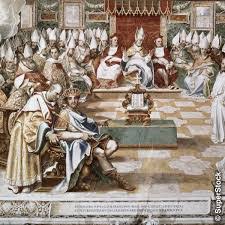The First Ecumenical Council

Pursuing the reign of Emperor Constantine in Nicomedia, the eastern capital after his victory of over Licinus, he was chagrined to learn of his new controversy that was troubling the whole Eastern Church by Arius, was a Protopresbyter of the Church of Alexandria.
In 315, he began to blaspheme against the Son of God uttering; He was not the true God, con-substantial with the Father, but rather a work or creation of God and different from the essence and glory of the Father. He also taught that the Son of God had a beginning. These teachings shook the faithful at Alexandria. The Bishop of Alexandria, Alexander, attempted to correct Arius through admonitions, cut him off from communion, and finally deposed him in 321 through a local council. Arius continued with his heretical teachings, creating controversy and division in the churches of other cities, which led to a theological and ecclesiastical crisis throughout the Christian Church.
Moved with divine zeal and concern for unity, the Emperor Constantine the Great, equal to the Apostles, summoned the First Ecumenical Council in Nicaea, a city of Bithynia. It was in this place that the bishops of the Church gathered in 325. All of them, with one mouth and one voice, declared that the Son and Word of God is one in essence with the Father, true God of true God. The Fathers composed the holy symbol of Faith, the Nicene Creed:
Ensuing, the advice of Saint Hoisus, Bishop of Spain (257–357), his theological advisor, he summoned the largest council of Bishops ever held up to the point. It opened on May 20, 325 in the City of Nicaea, near Nicomedia. Constantine himself gave the opening address. According to the tradition, 318 bishops were in attendance, including the famous and greatly beloved Saint Nicholas, Bishop of Myra in Lycia and Saint Spyridon, Bishop of Tremithus in Cyprus.
This council, known now as the first decreed that the Logos, the world and Son of God, is uncreated, ever existent and fully divine. He is begotten; that is born or generated from the Father and not created by Him. He is one of the essences with the father. He is true God of true God; The Word of God by whom all things were made. (John 1.3, Hebrew 1.2)
It is this uncreated, only-begotten, divine Son of God Who became man from the Virgin Mary as Jesus Christ, the Messiah of Israel and the Savior of the world.
The Council of Nicaea also decreed a number of canons (Church regulations) concerning various issues of order and discipline in the Church. Canon 6 confirmed the jurisdictional authority of Alexandria over Egypt and the neighboring regions of Libya and Pentapolis, “since the like is customary for the Bishop of Rome also (meaning that the Roman Church, in a corresponding way, had jurisdictional authority only over Rome and its neighboring territory at that time, most likely central Italy).
Likewise in Antioch and the other provinces let the Churches retain their privileges.” This canon clearly ratifies the ancient practice of the Churches in the major cities each having full jurisdictional authority only over the surrounding region. Concerning the lapsed, Canon 11 offered the possibility of restoration to Eucharistic communion, but only after a period of 12 years of heartfelt contrition, in three stages.
Concerning those who have fallen without compulsion, without the spoiling of their property, without danger or the like, as happened during the tyranny of Licinius, this Synod declares that, though they have deserved no mercy, they shall be dealt with mercifully. Those who were previously communicants, if they heartily repent, shall spend three years among the hearers; for seven years they shall be prostrators; and for two years they shall join the people in prayers, but still as yet without receiving the Eucharistic gifts.
Canon 20 prohibited the practice of penitential kneeling during the Church’s Sunday Liturgy, as well as during the entire Pentecostarion season.
The Nicene Council also established guidelines for determining the date of the annual celebration of Pascha, thus helping to bring the Quartodecimans’ practice to an end.
Lastly, this council affirmed once and for all, the propriety of allowing married men to be ordained as deacons, presbyters, even bishops and to still have a normal married life at least for the Eastern Churches. While the Roman Church during the 4th century began trying to force its clergy to be celibate, it was not until the 12th century that it was finally able to enforce this rule.
Source: Greek Orthodox Archdiocese of America
